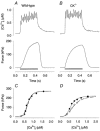Role of myoplasmic phosphate in contractile function of skeletal muscle: studies on creatine kinase-deficient mice
- PMID: 11389199
- PMCID: PMC2278644
- DOI: 10.1111/j.1469-7793.2001.0379a.x
Role of myoplasmic phosphate in contractile function of skeletal muscle: studies on creatine kinase-deficient mice
Abstract
1. Increased myoplasmic inorganic phosphate (P(i)) has been suggested to have an important role in skeletal muscle fatigue, especially in the early phase. In the present study we used intact fast-twitch muscle cells from mice completely deficient in creatine kinase (CK(-/-)) to test this suggestion. These CK(-/-) muscle cells provide a good model since they display a higher P(i) concentration in the unfatigued state and fatigue without significant increase of P(i). 2. Tetanic contractions (350 ms duration) were produced in intact single muscle fibres. The free myoplasmic [Ca(2+)] ([Ca(2+)](i)) was measured with the fluorescent indicator indo-1. The force-[Ca(2+)](i) relationship was constructed from tetani at different frequencies. 3. Compared with wild-type fibres, CK(-/-) fibres displayed lower force in 100 Hz tetani and at saturating [Ca(2+)](i) (i.e. 100 Hz stimulation during caffeine exposure), higher tetanic [Ca(2+)](i) during the first 100 ms of tetanic stimulation, reduced myofibrillar Ca(2+) sensitivity when measurements were performed 100-200 ms into tetani, and slowed force relaxation that was due to altered cross-bridge kinetics rather than delayed Ca(2+) removal from the myoplasm. 4. In wild-type fibres, a series of 10 tetani resulted in reduced tetanic force, slowed force relaxation, and increased amplitude of [Ca(2+)](i) tails after tetani. None of these changes were observed in CK(-/-) fibres. 5. Complementary experiments on isolated fast-twitch extensor digitorum longus muscles showed a reduction of tetanic force and relaxation speed in CK(-/-) muscles similar to those observed in single fibres. 6. In conclusion, increased P(i) concentration can explain changes observed in the early phase of skeletal muscle fatigue. Increased P(i) appears to be involved in both fatigue-induced changes of cross-bridge function and SR Ca(2+) handling.
Figures





Similar articles
-
Role of phosphate and calcium stores in muscle fatigue.J Physiol. 2001 Nov 1;536(Pt 3):657-65. doi: 10.1111/j.1469-7793.2001.t01-1-00657.x. J Physiol. 2001. PMID: 11691862 Free PMC article. Review.
-
Creatine kinase injection restores contractile function in creatine-kinase-deficient mouse skeletal muscle fibres.J Physiol. 2003 Mar 1;547(Pt 2):395-403. doi: 10.1113/jphysiol.2002.034793. Epub 2003 Jan 17. J Physiol. 2003. PMID: 12562893 Free PMC article.
-
Mitochondrial function in intact skeletal muscle fibres of creatine kinase deficient mice.J Physiol. 2003 Oct 15;552(Pt 2):393-402. doi: 10.1113/jphysiol.2003.050732. J Physiol. 2003. PMID: 14561823 Free PMC article.
-
Is creatine kinase responsible for fatigue? Studies of isolated skeletal muscle deficient in creatine kinase.FASEB J. 2000 May;14(7):982-90. doi: 10.1096/fasebj.14.7.982. FASEB J. 2000. PMID: 10783153
-
Mechanisms underlying changes of tetanic [Ca2+]i and force in skeletal muscle.Acta Physiol Scand. 1996 Mar;156(3):407-16. doi: 10.1046/j.1365-201X.1996.196000.x. Acta Physiol Scand. 1996. PMID: 8729701 Review.
Cited by
-
Inorganic phosphate affects the pCa-force relationship more than the pCa-ATPase by increasing the rate of dissociation of force generating cross-bridges in skinned fibers from both EDL and soleus muscles of the rat.J Muscle Res Cell Motil. 2004;25(2):107-17. doi: 10.1023/b:jure.0000035841.04314.16. J Muscle Res Cell Motil. 2004. PMID: 15360126
-
Structural and functional adaptations of striated muscles to CK deficiency.Mol Cell Biochem. 2004 Jan-Feb;256-257(1-2):29-41. doi: 10.1023/b:mcbi.0000009857.69730.97. Mol Cell Biochem. 2004. PMID: 14977168 Review.
-
Role of phosphate and calcium stores in muscle fatigue.J Physiol. 2001 Nov 1;536(Pt 3):657-65. doi: 10.1111/j.1469-7793.2001.t01-1-00657.x. J Physiol. 2001. PMID: 11691862 Free PMC article. Review.
-
Severity of arterial hypoxaemia affects the relative contributions of peripheral muscle fatigue to exercise performance in healthy humans.J Physiol. 2007 May 15;581(Pt 1):389-403. doi: 10.1113/jphysiol.2007.129700. Epub 2007 Feb 22. J Physiol. 2007. PMID: 17317739 Free PMC article. Clinical Trial.
-
Exploring the Link between Serum Phosphate Levels and Low Muscle Strength, Dynapenia, and Sarcopenia.Sci Rep. 2018 Feb 23;8(1):3573. doi: 10.1038/s41598-018-21784-1. Sci Rep. 2018. PMID: 29476104 Free PMC article.
References
-
- Allen DG, Lännergren J, Westerblad H. Muscle cell function during prolonged activity: cellular mechanisms of fatigue. Experimental Physiology. 1995;80:497–527. - PubMed
-
- Balog EM, Fruen BR, Kane PK, Louis CF. Mechanisms of Pi regulation of the skeletal muscle SR Ca2+ release channel. American Journal of Physiology. 2000;278:C601–611. - PubMed
Publication types
MeSH terms
Substances
LinkOut - more resources
Full Text Sources
Molecular Biology Databases
Research Materials
Miscellaneous

